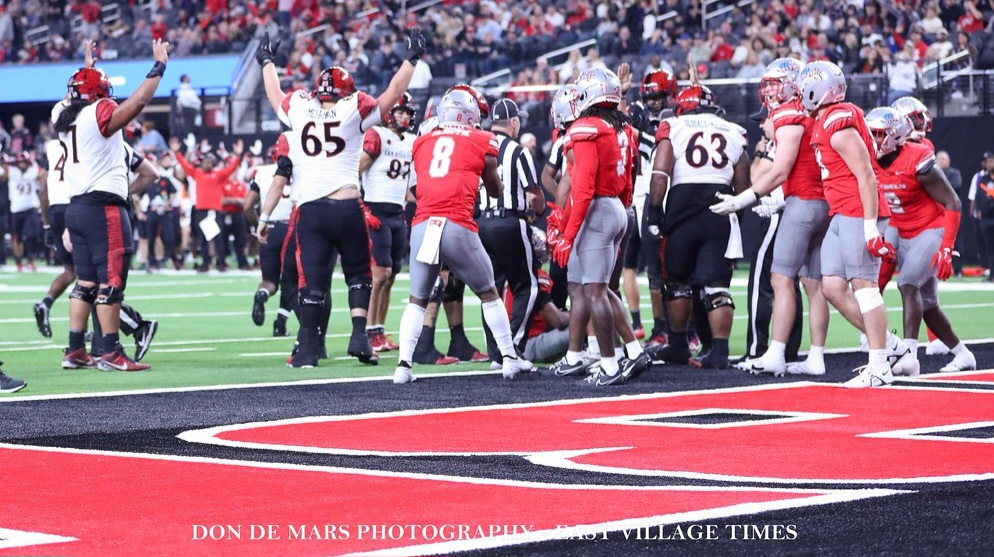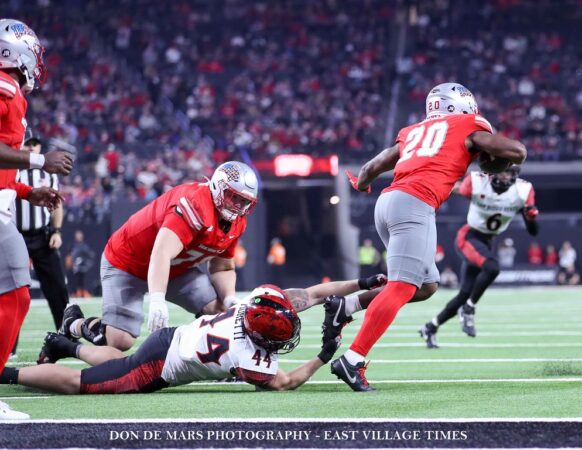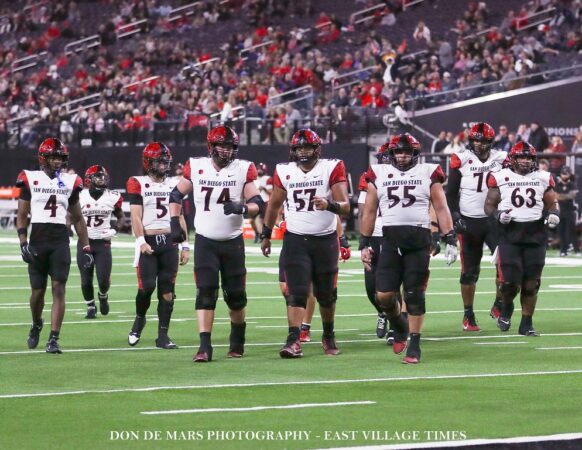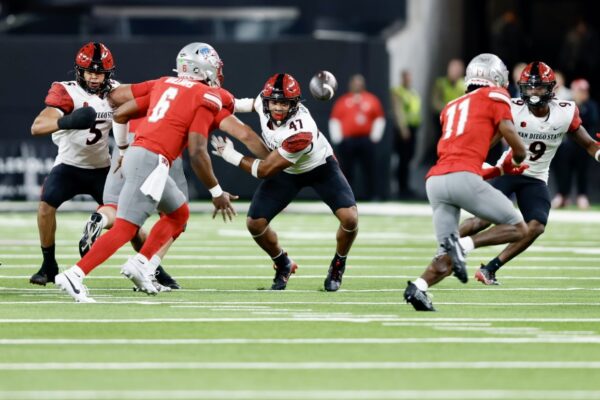SDSU vs. Utah State: Ten Things to Watch

Tyler McMahan helps the refs with the correct call on Danny O'Neil's QB sneak. (Don De Mars/EVT)

San Diego State and Utah State will meet this weekend for the 18th time in the series. The Aggies, whose program started in 1892, have faced the Aztecs more than all but 18 teams in their football program’s history.
SDSU’s contest against USU follows a familiar pattern. Like many of the Mountain West foes on the Aztecs’ 2024 schedule, the Red and Black dominate the rivalry. They are 13-4 all-time against Utah State, including a perfect 5-0 in Logan, Utah, where Saturday’s contest will be held.
As the Aztecs attempt to rebuild and rebrand their approach under head coach Sean Lewis, 2024 has clarified the first step in that process. They need victories in the games they are supposed to win. Two 7-6 seasons during their 13-year bowl eligibility streak from 2010 to 2022 provide illuminating examples.
In 2014 and 2018, only three of the Red and Black’s 14 cumulative wins came against teams that finished the year with a winning record. The ceilings for these iterations of Aztec football were not very high, but the staff and players fought to ensure the floor was not low either.
In defeating traditionally weak teams like UNLV, New Mexico, San Jose State, and Hawai’i, SDSU guaranteed themselves winning seasons, kept the momentum in the program, and bought time for the next wave of NFL players to develop on The Mesa. The 2014 and 2018 seasons were followed by double-digit wins in 2015 and 2019.
The Aztecs are 3-7 in 2024. Losses to Central Michigan (3-7) and New Mexico (5-6) prevented Lewis from leading the team to a bowl in his first year with the program. As attention turns to 2025, the progression is clear. SDSU needs to re-establish its dominance over schools with less pedigree. Utah State (3-7) this week and Air Force (3-7) to end the season would be great steps in that direction.
Here are ten things to watch in the Aztecs’ matchup with the Aggies.
10. Playing the reserves
Lewis has responded curiously when asked about his offense’s poor performance this year. He has primarily blamed himself while mentioning the health issues that have prevented SDSU from excelling. Many starters have been unavailable in practice because they have been game-time decisions.
Since the start of the year, Lewis has given snaps to only a handful of position players, but this group has yet to succeed. If the starters cannot compete consistently in the dress rehearsals leading up to games and that is causing the offense’s poor production, would Lewis be better served playing their understudies who have been taking the reps in practice?
Player development also factors into this equation. Bowls allow extra practice time. Much of that is utilized to improve a team’s younger athletes. Without that luxury this season, could Lewis use the final two weeks as an introduction to the college game for those buried on the depth chart?
Marquez Cooper, Ja’Shaun Poke, JD Coffey III, Deshawn Mccuin, Marlem Louis, Nate Williams, Bryce Phillips, William Nimmo, Brayden Bryant, Cody Moon, Tyler Pastula, Ryan Wintermeyer, and Tupu Alualu are among the 15 Aztecs in their final year of eligibilty. Would it be prudent to lessen the snaps they receive so Aztecs, who will be on the roster next year, can gain some experience?
Like much in college football, NIL might have ruined this common-sense approach. A clear pattern is seen for former Aztecs who have entered the transfer portal. Aside from a few exceptions, athletes without game film drop to the FCS or junior college levels to continue playing. Would providing snaps make it more likely for a prospect to leave?
Lewis said this week that no one across the country has solved the problems NIL and the transfer portal created. It will be interesting to track how he and his staff navigate that minefield against Utah State.

9. Spoiling Senior Night
The Aggies have hovered around .500 in their long football history. An exception to that mediocrity is their play on senior night. Saturday marks the 117th time the Logan community has honored the athletes in their final year at the university. The Aggies are 71-42-3 in those contests. They have won seven of the past 11.
When asked postgame following SDSU’s loss to UNLV what the team has to play for now that their bowl hopes were dashed, Cooper answered, “pride” without hesitation. While competing for oneself is admirable, playing spoiler could add some motivation.
Since the Aggies joined the Mountain West, the Aztecs have only played at Utah State twice. As future partners in the Pac-12, this trip will be a consistent part of SDSU’s life. Ruining the final game for USU seniors would be a great way to kick off the next chapter in the rivalry.
8. Matching Last Year’s Win Total
Changing philosophy from what has made SDSU successful since 2010 to an approach that has a better chance of filling Snapdragon Stadium and generating NIL contributions was always fraught with danger. If the Aztecs had made the postseason in 2024, the worry that the administration had thrown the baby out with the bath water when it hired Lewis would be over. With the possibility of a bowl behind the team, evaluating this season takes on a different dimension.
Andre Haghverdian put it well in an article this week when he spelled out that SDSU’s performance next year will decide if 2024 was a stepping stone or a step back. Without the advantage of hindsight, SDSU could clarify how to look at this year by matching last season’s win total.
It might be naive to expect college football’s middle class to fill roster holes via the transfer portal. The athletes SDSU lost in 2023 were not adequately replaced by who they brought in. Unless the Aztecs retain most of their roster, it is doubtful the portal will be a net positive for them.
Retention and development will be key to SDSU’s 2025 chances. If Lewis’ squad matches the 2023 record with a less mature roster, it will be tangible proof that the program might be headed in the right direction. Lose the final two contests, and the door will be open for doubt and uncertainty.

7. Making Utah State One-Dimensional
Last week was the only time all year that Utah State ran the ball more than it passed. Considering USU had 321 yards on the ground and 259 through the air, the 42-32 run/pass split shows that the Aggies like to throw it.
A key for the Aztecs will be making USU one-dimensional by stopping the run without dedicating too many defenders to it. The forecast for Saturday is in the high 40s, and rain is expected to fall on 25% to 40% of Logan during the game. It will be interesting to see how the weather factors into the contest.
SDSU did well against the two pass-first teams on its schedule, Hawai’i and Washington State. Utah State offers more balance than the Rainbow Warriors or Cougars, but it fits well in that group. The Aggies are dedicated to the run. After their success last week and the Aztecs’ struggles to stop opposing ground attacks most of the season, the running game could prove crucial on Saturday.
6. Tackling Machine
New Mexico State transfer safety Jordan Vincent is the reigning Mountain West Defensive Player of the Week after recording two interceptions and five tackles against Hawai’i last weekend. His stops were the second-fewest of the season and only the third time he failed to reach triple digits.
Overall, Vincent is second in the Mountain West and 12th in the nation in tackles per game (9.2). He has reached double digits in tackles 11 times in his career. Vincent has at least ten stops in seven games this season, which is the most in the conference and tied for the third-most in the nation.
It will be important for the Aztecs to limit Vincent’s impact on Saturday. Ike Larson is next on the team with 69 stops.

5. Protecting the Football
Utah State forced a season-high five turnovers on five interceptions in its last game against Hawai’i. Those five picks were the most for USU since 1971. After starting the season excelling at taking care of the football with only two turnovers in the first five games, the Aztecs have grown careless in the last five contests.
Freshman QB Danny O’Neil has accounted for all of them, throwing six interceptions during the span. O’Neil ranks tied for 378 out of 460 signal callers for the fewest interceptions thrown in the country.
The Aztecs have not lost a fumble since O’Neil’s in the season’s second game. They have only put the ball on the ground once all year. SDSU’s season-long trend is that the offense almost exclusively puts up points when they have a short field or create an explosive play. Utah State is 118th in the nation in turnovers lost. The Red and Black need to capitalize on any mistakes the Aggies make.
4. Danny O’Neil starting the game well
O’Neil has thrown the 56th most passes in the FBS season. He ranks 84th with 1,752 yards. His ESPN QBR is 123rd out of 131 signal callers evaluated. Comparing his season to others around the Mountain West, he has been in the conference’s bottom half among signal callers.
O’Neil ranks sixth in attempts (267) and completion percentage (60.7), seventh in yards per game (194.7) and touchdowns thrown (11), and eighth in QB rating (124.9). His best stat is interceptions thrown (6). O’Neil ranks fifth in that category.
Chief among his improvements for Saturday will be the way he starts the game. There is a chance the Aztecs will fold due to a lack of confidence, and O’Neil starting the game off well would be a boost for the team.
Only once all year has he thrown for more than 100 yards in the first quarter (118 vs. Central Michigan). He started well against Hawai’i (10-11 for 67 yards) and New Mexico (11-11 for 80 yards). Of his remaining six starts, the 35 yards he threw in the opening period against UNLV last week was the most.
Overall, he is 51-88 (58%) for 435 yards and three interceptions. O’Neil has led one touchdown drive in the opening 15 minutes of a contest this season. The young signal-caller has thrown for over 200 yards three times this season. Two of them were in the contests where he started strong. He nearly got there against New Mexico (195 yards).

3. Scouting the Quarterbacks
Instead of seeking a veteran transfer, Lewis filled his quarterback room with unproven and younger signal callers. Utah State took the opposite approach. This offseason, they brought in three transfers from P4 schools. Iowa transfer Spencer Petras won the competition.
Petras leads the Mountain West and is eighth in the FBS, averaging 286 yards per game. Only twice in his eight starts has he failed to throw for 200 yards. Handing the keys of the offense to a veteran signal-caller paid off the Aggies.
On the other hand, Petras is in his final year of eligibility. Utah State head coach Nate Dreiling still has the interim label attached to his role. He likely needed more from Petras than impressive stats to earn the job outright. Dreiling needed wins.
The Aggies have the same record as the Aztecs but will not have a returning quarterback next season. Assuming O’Neil is back on The Mesa, he will have a lot of experience to build on heading into next year. However, the position plays out for SDSU in 2025; it will be much better than in 2024.
This offseason, expect O’Neil to make a significant leap in production. If a transfer, one of this season’s backups, or true freshman JP Mialovski beats him out for the job, they will earn it because 2025 will likely reveal a better version of O’Neil than anything seen to date.
2. Trey White
The sophomore EDGE has been held to no sacks in four contests this year. Three of them have come in SDSU’s last three games. Before this stretch, the defense looked solid and better than the other side of the ball. White’s dominance played a significant role in that production. His play elevated the defense and masked some of the shortcomings.
Heading into its contest with Boise State, SDSU averaged a respectable 23.6 points given up per game, 376 yards per contest, and 5.1 yards per play. The Broncos, Lobos, and Rebels minimized White’s impact through their scheme and frequent double teams. The Aztecs play dropped off significantly.
Against BSU, UM, and UNLV, SDSU gave up an average of 510.1 yards per game, a staggering seven yards per play, and 39 points per contest. During the stretch and for the first time all year, the Aztecs resembled Lewis’ defenses at Kent State.
With the game out of hand last week, White received a lot of rest. The Aztecs could use their team captain at his best on Saturday against Utah State.

1. Reversing the numbers
SDSU’s opponents have found more success against the Aztecs than the other teams on their schedules.
In terms of yards given up against FBS teams, Oregon State and Boise State had their best games of the year against SDSU. Cal, Hawai’i, Wyoming, New Mexico, and UNLV gave up their second-lowest totals. The Aztecs had better results against Central Michigan and Washington State, but those squads’ defenses still managed their fourth-best outings matching up with SDSU’s offense.
Opposing offenses also enjoyed playing the Aztecs. UNLV and Central Michigan gained their second-most yards against FBS teams when they competed against SDSU. Cal, Wyoming, and Boise State had their third-best outings. Oregon State (4th), Hawai’i (4th), and New Mexico (5th) had middling performances versus the Aztecs. Only Washington State was held significantly lower by SDSU’s defense. The Cougars offense produced its eighth worst day of the season.
Utah State is eighth in total offense. They average 463.9 yards each contest. The Aggies are 130th in total defense, giving up a staggering 477.5 yards each game. A storyline to follow is if the Aztecs better these marks on Saturday.
My earliest sport’s memory involve tailgating at the Murph, running down the circular exit ramps, and seeing the Padres, Chargers and Aztecs play. As a second generation Aztec, I am passionate about all things SDSU. Other interests include raising my four children, being a great husband and teaching high school.